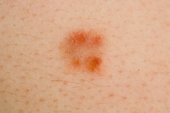Melanoma forms when malignant cancer cells form in the cells that color the skin (called melanocytes). These melanocyte skin cells make melanin, which is the pigment that gives skin its natural color. Melanocytes are found in the lower part of the top layer of skin, or epidermis. Sun exposure causes these cells to produce more pigment which is why the skin darkens in color, or tans.
The Two Skin Layers
As the body’s largest organ, the skin is vital for protection against injury, infection, and heat. It has two main layers, which allow it to protect us: the dermis and the epidermis. The dermis is the lower or inner layer of the skin, and the epidermis is the upper or outer layer. With the skin being your first line of defense, it is vulnerable, especially to various cancers.
The Three Types of Skin Cancer
There are three specific types of skin cancer that can weaken your body’s defense. These include:
- Melanoma
- Basal Cell Carcinoma
- Squamous Cell Carcinoma
Rare Forms of Melanoma
Melanoma can occur in different parts of the body. It even occurs in the mucus membranes (the thin moist layers of the tissues that cover the lips and line the nose). This rare form of melanoma is known as cutaneous melanoma. If it starts in the skin of tissue of the eye, it is called intraocular or ocular melanoma, another rare type of skin cancer. Melanoma is more aggressive then basal cell carcinoma (BCC) or squamous cell carcinoma (SCC). In men, it is often found on the area from the shoulders to the hips, or the trunk. For women, it is most often found on the arms and legs. Though melanoma most commonly occurs in adults, it can sometimes affect children or adolescents.
Melanoma Risk Factors
Whatever increases your risk of getting a disease is called a risk factor. Having a risk factor does not mean that you will get cancer. On the other hand, not having any risk factors does not ensure you cannot get cancer. If you think you may be at risk, talk to your dermatologist. Here is a list of risk factors that you should discuss:
- Fair complexion – includes skin that freckles and burns easily, does not tan, or tans poorly
- Light eye color – having blue, green, gray, amber, or other colors of light eyes
- Red or blond hair color – having hair that is red or light colored
- Sun exposures – being exposed to natural or artificial sunlight for long periods of time
- A history of blistering sunburns – especially as a child or teenager
- Moles – having several large moles or many small ones
- A family history of unusual moles – this is also called atypical nevus syndrome
- History of melanoma – includes a personal or family history of melanoma
- Race –Caucasian people have more melanoma
Signs and Symptoms of Melanoma
There are many signs and symptoms of melanoma. These include a mole that:
- Changes in size, shape or color
- Has irregular edges or borders
- Is more than one color
- Is asymmetrical (two halves are different sizes or shapes)
- Itches or burns
- Oozes, bleeds, or ulcerates (a hole forms in the top layer of skin)
- Has recently had new moles growing near it
Testing and Diagnosing Melanoma
If a mole or pigmented area of the skin changes or looks abnormal, your dermatologists can do diagnostic testing and procedures to detect melanoma and other forms of skin cancer. These tests and procedures include:
- Skin Exam: This is an exam where the doctor or nurse checks the skin for moles, birthmarks or other pigmented areas that look abnormal in color, size, shape or texture.
- Biopsy: If any abnormal moles or lesions are found, the dermatologist removes as much of it as possible in a procedure called a biopsy. He sends the tissue sample to a laboratory where a pathologist looks at it under a microscope to check for cancer cells. The difference in a colored mole and an early melanoma lesion is slight and hard to detect, so many patients have their biopsy checked by a second pathologist.
Factors that affect Melanoma Recovery, Prognosis and Treatment Options
The chance of recovery, prognosis, and treatment options all depend on several factors. These include:
- The thickness of the tumor or lesion
- Where the tumor or lesion is on the body
- How quickly the cancer cells divide
- Whether there was bleeding or ulceration at the primary site
- Whether cancer has spread to the lymph nodes or other places
- The number of places where the melanoma has spread
- The level of lactate dehydrogenate (LDH) in the blood
- The patient’s general health

